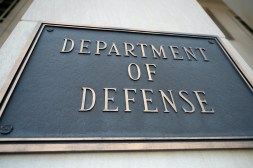‘Night courts’ come to the Navy as it seeks $40B reinvest in priorities like digital modernization

Acting Sectary of the Navy Thomas Modly is looking to shake $40 billion out of the Navy’s budget over the next five years to reinvest in top “strategic priorities” including digital modernization.
At the top of Modly’s hit list is reducing the money spent on “duplication of information technology systems and infrastructure,” according to a memo he issued Tuesday that launched the budgetary review. Other priorities for reinvestment are putting money in nuclear forces and increasing the number of ships in the Navy.
The Navy must “act now to make tough, fiscally-informed choices in order to fund our key strategic priorities using the budget we have, not the budget we wish we had,” Modly wrote in the memo, first reported on by USNI news.
Under President Trump’s fiscal 2021 budget request, spending on the Navy would dip to $207 billion, down from an estimated $210 billion this year. Modly and his uniformed counterparts, Chief of Naval Operations Michael Gilday and Marine Corps Commandant David Berger, will report to the House and Senate over the next two weeks to defend their request. It’s a task Modly anticipates will be “challenging.”
The move is similar to the Army’s so-called “night courts” where then-Army Secretary Mark Esper slashed budgets of old programs to reinvest money into programs like cloud migration and other initiatives. Now as Defense secretary, Esper brought the idea with him after he was promoted, issuing a “Defense-Wide Review” as a part of the recent $705 billion budget request for the military as a whole. It is not clear the exact dollar-amount impact the Navy and DOD-wide reviews will have on IT modernization and emerging technology, but the Army found over $700 million for cloud investment in its reviews from the last few years.
The Navy has been giving the political imperative of building a 355-ship fleet, a lift that will require significant funding. Apart from increasing the number of ships from the current roughly 290 , improving technology on those ships will be critical. A recent Center for Strategic and Budgetary Analysis report noted that linking the communications and data between ships will be one of the most critical parts of increasing fleet sizes.
The Navy’s stated technology goals center on cybersecurity, artificial intelligence, cloud computing and Command, Control and Communications (C3), according to the department’s digital modernization strategy.
Cybersecurity remains a critical challenge for the Navy. The department received a blistering review of its cyber readiness and has suffered from breaches.
Artificial intelligence has not received the same amount of public hype in the Navy as the emerging technology has in other services. The service created the Navy Center for Applied Research in Artificial Intelligence in 1981, but no new task force or fielding center, as has happened within the Army and at the departmentwide level with the Joint AI Center (JAIC).






